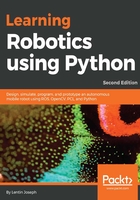
Wheel, motor, and motor clamp design
We have to decide the diameter of the wheel and compute motor requirements. Here, we are giving a typical motor and wheel that we can use if the design is successful:

Motor design of robot
The motor design can vary according to the motor selection; if necessary, this motor can be taken as the design and can change after simulation. The L value in the motor diagram can vary according to the speed and torque of the motors. This is the gear assembly of the motor.
The following diagram shows a typical wheel that we can use with a diameter of 90 cm. The wheel with a diameter of 86.5 mm will become 90 mm after placing the grip:

Wheel design of robot
The motors need to be mounted on the base plate. To mount, we need a clamp that can be screwed onto the plate and also connect the motor to the clamp. The following diagram shows a typical clamp that we can use for this purpose. It's an L-shaped clamp with which we can mount the motor on one side and fit another side to the plate:

Typical clamp design of robot